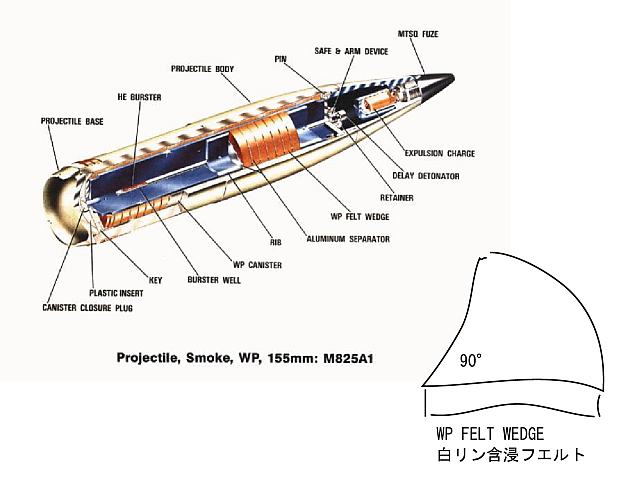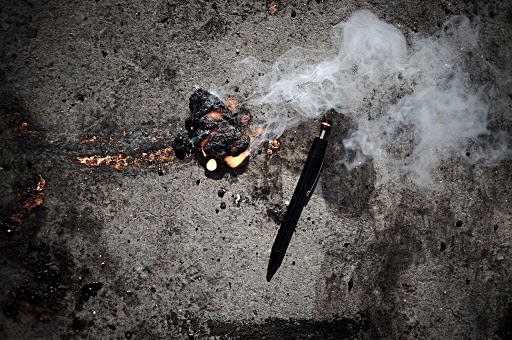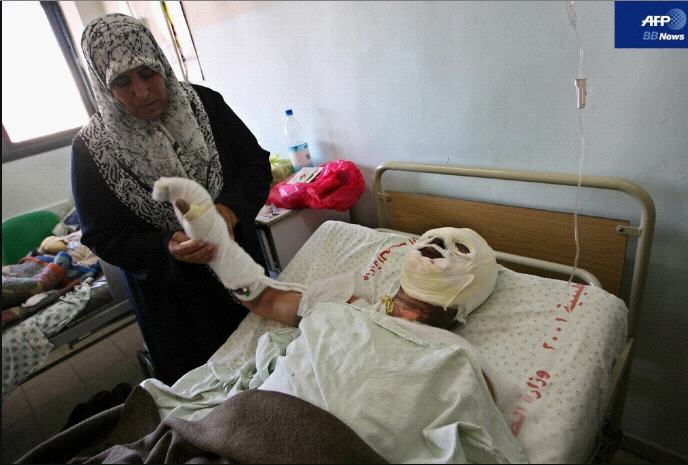GAZA兵器と人間・資料庫 @ wiki
globalsecurity.org:White Phosphorus (WP)
最終更新:
pipopipo777
-
view
GlobalSecurity.org
Military
Military
White Phosphorus (WP) 試訳と注解

(abstract)概要
White Phosphorus (WP), known as Willy Pete, is used for signaling, screening, and incendiary purposes. White Phosphorus can be used to destroy the enemy's equipment or to limit his vision. It is used against vehicles, petroleum, oils and lubricants (POL) and ammunition storage areas, and enemy observers. WP can be used as an aid in target location and navigation. It is usually dispersed by explosive munitions. It can be fired with fuze time to obtain an airburst. White phosphorus was used most often during World War II in military formulations for smoke screens, marker shells, incendiaries, hand grenades, smoke markers, colored flares, and tracer bullets.
白リン弾(WP)は、ウィリー・ピート(=Willy Pete)の名で知られるが、信号、煙幕、焼夷の目的で使われる。白リン弾は敵の装備を破壊したり敵の視野を制限するために使うことができる。車両や石油施設、および弾薬貯蔵エリア、敵の観測部隊に対して用いられる。白リン(WP)は目標定位や方向誘導の補助として使うことができる。白リンは通常、爆発性の弾薬を使って撒布される。時限信管をつけて発射され空中爆発させることができる。白リンは、第2次大戦中には陸軍の制式兵器として、煙幕、標識弾、焼夷弾、手榴弾、煙標識、着色炎、そして曳光弾にと、頻繁に使われた。
- (引用者注)petroleum, oils and lubricants (POL) は慣用句で「石油施設」。直訳すれば、石油、油脂、潤滑油だが、petroleum, oils and lubricants line(POL line) で送油管、petroleum, oils and lubricants tank(POL tank) でオイルタンク。」
The Battle of Fallujah was conducted from 8 to 20 November 2004 with the last fire mission on 17 November. The battle was fought by an Army, Marine and Iraqi force of about 15,000 under the I Marine Expeditionary Force (I-MEF). US forces found WP to be useful in the Battle of Fallujah. "WP proved to be an effective and versatile munition. We used it for screening missions at two breeches and, later in the fight, as a potent psychological weapon against the insurgents in trench lines and spider holes when we could not get effects on them with HE. We fired “shake and bake” missions at the insurgents, using WP to flush them out and HE to take them out. ... We used improved WP for screening missions when HC smoke would have been more effective and saved our WP for lethal missions."
ファルージャの戦闘は、2004年の11月8日から20日まで実施された。最後の砲撃は11月17日であった。戦闘は、第一海兵遠征軍(I-MEF)のもと、米陸軍、米海兵隊、イラク軍の混成15,000人の将兵によって闘われた。合衆国軍はファルージャの戦闘で、白リン弾が有効であることに気付いた。
『白リン弾が、効果的で広い用途に使えることが分かりました。煙幕作戦で我々は、白リン弾を2基の後装砲から発射し、後には戦闘中、塹壕やクモの穴にいる反乱ゲリラに対して、高性能爆薬弾が効果を示さないときに、心理的効果がある兵器として用いました。我々は反乱軍に対して、“shake and bake(揺すってから焼く)作戦”・・・つまり、まず白リン弾を使って反乱軍を追い出し、その後に高性能爆薬弾で仕留める、というやり方で砲撃しました。我々は煙幕作戦では、HC smoke(Hexachloroethane Zinc:ヘキサクロロエタン亜鉛の発煙弾)の方が有効だと思われるときでも改良白リン弾を使いましたが、我々の白リン弾は最終作戦のために取っておきました。』
- (引用者注)「at two breeches」とは何でしょう。私は、迫撃砲と対置する「breechloaoding=後装銃(砲)」ではないかと思いました。
- (引用者注)“shake and bake作戦”については、BBCの記事が詳しいです。
参照⇒“http://www36.atwiki.jp/pipopipo777/pages/47.html - (引用者注)「改良白リン弾=improved WP」 とは、新しい爆弾、空中爆発の155mm砲弾のM825A1と思われます。それに対して「我々の白リン弾=our WP」とは、120mm迫撃砲用の白リン弾のことだと思われます。
- (引用者注)globalsecurityが引用したソースの記事は、米国防総省が白リン弾使用否定を覆さざるを得なくなった兵士たちの手記です。http://www.tradoc.army.mil/pao/ProfWriting/2-2AARlow.pdfです。
White phosphorus is not banned by any treaty to which the United States is a signatory. Smokes and obscurants comprise a category of materials that are not used militarily as direct chemical agents.
白リン弾は、合衆国が加盟国となっているどんな条約においても禁止されていない。発煙弾と焼夷弾の中に含む物質は、直接的な化学薬剤作用を軍事利用したとはいえないカテゴリーに属する。
- (引用者注)化学兵器禁止条約の一覧表に載ってはいない物質だ、の意と思われます。
The United States retains its ability to employ incendiaries to hold high-priority military targets at risk in a manner consistent with the principle of proportionality that governs the use of all weapons under existing law.
合衆国は、現行する法の下に全ての兵器使用を統治しなければならないという均衡原則を貫く上で障害があるとはいえ、最優先軍事目標の制圧目的で焼夷兵器を採用する可能性(権利)を留保している。
The use of white phosphorus or fuel air explosives are not prohibited or restricted by Protocol III of the Certain Conventional Weapons Convention (CCWC), the Convention on Prohibitions or Restrictions on the Use of Certain Conventional Weapons which may be Deemed to be Excessively Injurious or to have Indiscriminate Effects, which regulates the use of "any weapon or munition which is primarily designed to set fire to objects or to cause burn injury to persons . . ."
白リンや石油の使用は、『過剰な傷害』や『無差別的効果』を持つと見なされる通常兵器を禁止あるいは制限する条約である、通常兵器に関する条約(CCWC)の議定書IIIでは、禁止も制限もされてはいないが、この条約は、「そもそも、どんな兵器だって弾薬だって、目標を攻撃するためであったり人間に火傷を引き起こすために設計されているじゃないか.....」と合衆国が主張することを制約している。
- (引用者注)国際法の上で白リン弾をどう見るべきか、赤十字国際委員会はガザ戦争の最中に見解を発表している、それは、このglobalsecurityのアメリカ政府に対する見解よりもイスラエルに手厳しい。
参照⇒http://ni0615.iza.ne.jp/blog/entry/881757/ - (引用者注)また、アムネスティ・インタナショナルもガザ現地の実態調査に基づいて、イスラエル軍による白リン弾使用を強く批判している。
参照⇒http://www36.atwiki.jp/pipopipo777/pages/55.html
White Phosphorus (WP) - Incendiary 焼夷性
WP is a colorless to yellow translucent wax-like substance with a pungent, garlic-like smell. The form used by the military is highly energetic (active) and ignites once it is exposed to oxygen. White phosphorus is a pyrophoric material, that is, it is spontaneously flammable).
白リン(=WP)は、無色ないしは黄色い半透明のワックス状の物質で、ニンニク様の刺激臭がある。兵器として使われる分子構造は高エネルギー(高活性)で、酸素に触れると即時に発火する。白リンは自燃発火性物質、すなわち自発的に燃えあがる物質である。
When exposed to air, it spontaneously ignites and is oxidized rapidly to phosphorus pentoxide. Such heat is produced by this reaction that the element bursts into a yellow flame and produces a dense white smoke. Phosphorus also becomes luminous in the dark, and this property is conveyed to "tracer bullets." This chemical reaction continues until either all the material is consumed or the element is deprived of oxygen. Up to 15 percent of the WP remains within the charred wedge and can reignite if the felt is crushed and the unburned WP is exposed to the atmosphere.
空気にさらすと、自然に発火して急速に酸化して五酸化リンとなる。反応の際発生する熱はかなりのものだ。成分は爆発して黄色い炎となり濃い白煙をつくる。また、リンは暗闇で発光し、その特性は「曳光弾」として利用される。 すべての材料が消費されるか或いは反応場から酸素が奪いつくされるまでこの化学反応は続く。 白リン(=WP)の最大15パーセントは、黒焦げたくさび(=wedge)に残って、フェルトが砕けて燃え残りの白リンが大気にさらされると、再発火する。
- (引用者注)the element:その成分 element:活動環境、反応場
- (引用者注)げたくさび(=wedge)とは、⇒下図「白リン含浸FELT WEDGE 参照。ただし、下図は150mm砲用の砲弾 M825A1 であって、先に紹介された120mm迫撃砲用白リン弾の構造は不明です。
Fas.org の図 に「Wedge」を書き添えたもの
Alleged burning white phosphorous at the UNRWA's warehouse
AFPBB より
AFPBB より
- (引用者注)白リンの最大15パーセントが燃え残って再発火を繰り返すことは、1月18日の停戦直後にガザに入ったガーディアン紙ビデオクルーが動画で捉えています。また、アムネスティインタナショナルも、その報告書にこのことを記述しています。WEB上には何故か白リン弾を擁護したい人たちがいて、「1つのwedgeのわずか50gの白リンなんか、数分間で燃え尽きてしまうさ」という趣旨の発言が見受けられますが、これは全く事実に反しています。大事なことは、白リンがいつまでも発火源として残るため火災の危険性を消せない、ということです。これは続いて述べられている化学火傷の再発とも共通する、白リン弾の化学性及び焼夷性の同時発現といえましょう。
White phosphorus results in painful chemical burn injuries. The resultant burn typically appears as a necrotic area with a yellowish color and characteristic garliclike odor. White phosphorus is highly lipid soluble and as such, is believed to have rapid dermal penetration once particles are embedded under the skin. Because of its enhanced lipid solubility, many have believed that these injuries result in delayed wound healing. This has not been well studied; therefore, all that can be stated is that white phosphorus burns represent a small subsegment of chemical burns, all of which typically result in delayed wound healing.
白リンは、大きな苦痛を伴う化学火傷を引き起こす。 このやけどの特徴は、最終的に黄ばんだ色と独特のニンニク臭をともなう壊死部位となることである。 白リンには高い脂溶性があり、それゆえに小片がいったん皮膚に埋め込まれると、急速な皮膚浸透力を発揮するとされている。 高い脂溶性のために負傷者の傷の快復が遅れるとされている。 まだ研究が進んでないことだが、総じて言い得る事は、白リンのやけどは、いずれも快復の遅れを招くことの多い、化学火傷の小区域を示します。
- (引用者注)subsegment :segment は組織学的な「区域」。subsegment はその中の「小区域」、医学書では「亜区域」と訳されている言葉だが、ここでの使い方は専門的に厳密な定義によるものではないだろう。
Incandescent particles of WP may produce extensive burns. Phosphorus burns on the skin are deep and painful; a firm eschar is produced and is surrounded by vesiculation. The burns usually are multiple, deep, and variable in size. The solid in the eye produces severe injury. The particles continue to burn unless deprived of atmospheric oxygen. Contact with these particles can cause local burns. These weapons are particularly nasty because white phosphorus continues to burn until it disappears. If service members are hit by pieces of white phosphorus, it could burn right down to the bone. Burns usually are limited to areas of exposed skin (upper extremities, face). Burns frequently are second and third degree because of the rapid ignition and highly lipophilic properties of white phosphorus.
燃え上がる白リン小片は広範囲の熱傷を発生させるだろう。 皮膚の上にできるリンのやけどは深くて苦痛が大きい。 堅い焼痂ができてそれは水疱によって囲まれる。 通常、火傷はあちこちにでき、深くて大きさも様々だ。 また、リンの固体小片が目に入ると、重症の傷害となる。 空気中の酸素が欠乏するまでその小片は燃え続ける。 白リンの小片に触れると、そこに局所火傷を引き起こす。 白リンが消失するまで燃え続けるので、この兵器は極めて残忍だ。 兵隊が白リンの破片を被弾すれば、白リンは徹底的に、骨に達するまで燃えつづけるかもしれない。 通常、火傷は露出した皮膚(腕の先端や顔)の領域に限られる。 火傷は、急速な発火性と白リンの高い脂肪親和性のために、しばしば第II、第III度の重症火傷になっている。
- (引用者注)burnsを「熱傷」と訳する向きもあるが、これは「高熱」による火傷ではなく、「化学反応」による「化学火傷」であることが明らかなので、それは採用しません。
If burning particles of WP strike and stick to the clothing, take off the contaminated clothing quickly before the WP burns through to the skin. Remove quickly all clothing affected by phosphorus to prevent phosphorus burning through to skin. If this is impossible, plunge skin or clothing affected by phosphorus in cold water or moisten strongly to extinguish or prevent fire. Then immediately remove affected clothing and rinse affected skin areas with cold sodium bicarbonate solution or with cold water. Moisten skin and remove visible phosphorus (preferably under water) with squared object (knife-back etc.) or tweezers. Do not touch phosphorus with fingers! Throw removed phosphorus or clothing affected by phosphorus into water or allow to bum in suitable location. Cover phosphorus burns with moist dressing and keep moist to prevent renewed inflammation. It is neccessary to dress white phosphorus-injured patients with saline-soaked dressings to prevent reignition of the phosphorus by contact with the air.
もし白リン(=WP)の燃焼小片が衣服に当たり付着したら、燃焼が皮膚に達する前にすばやく白リンで汚染された衣服を脱ぐこと。そして、燃焼が皮膚に達することを防ぐ為に総ての衣服もすばやく脱ぐこと。もしそれが出来ないときは、リンに影響された皮膚や衣類は冷たい水に突っ込むか、消火や防火のためしっかり濡らすこと。然る後速やかに、影響受けた衣服を脱いで、皮膚は冷たい重炭酸ナトリウム溶液か冷たい水で濯ぐこと。目視できるリンは、皮膚を濡らしながら(できるなら水にくぐらせたまま)角張ったもの(ナイフの柄とか)やピンセットで取り除くこと。指でリンを触ってはならない! 取り除いたリンやリンの影響を受けた衣服は、水の中に投げ込むか適切な場所に廃棄すること。火傷は濡らした包帯で覆い、濡らすことによって再発火を防ぐこと。白リンによって負傷した患者には塩水を染み込ました包帯を巻いて、空気に触れて再発火することを防がねばならない。
AFPBBニュースより
Some nations recommend washing the skin with a 0.5-2.0% copper sulphate solution or a copper sulphate impregnated pad. Wounds may be rinsed with a 0.1%-0.2% copper sulphate solution, if available. Dark coloured deposits may be removed with forceps. Prevent prolonged contact of any copper sulphate preparations with the tissues by prompt, copious flushing with water or saline, as there is a definite danger of copper poisoning. It may be necessary to repeat the first aid measures to completely remove all phosphorus.
一部の国々では、0.5~2.0%の硫酸銅溶液か硫酸銅含浸パッドで皮膚を洗浄することが推奨されている。用意できるなら(そのあと)0.1%から0.2%の硫酸銅溶液で傷口をすすぐこと。黒くなった火傷のかさぶたは鉗子で取り除くこと。 できるだけ多くの水か塩水を傷口に流して、硫酸銅調剤と組織との長時間の接触を防ぐこと。そうすることによって銅の毒による致命的な危険性を防止すること。繰り返しになるが、最初の救急で全てのリンを、しらみつぶしに完全に取り除くことが肝要である。
White Phosphorus (WP) - Smoke 発煙
White Phosphorus (WP) creates a smoke screen as it burns. Phosphorus smokes are generated by a variety of munitions. Some of these munitions such as the M825 (155-mm round) may, on explosion, distribute particles of incompletely oxidized white phosphorus.
白リン弾 (WP) は燃えながら煙をつくる。リンの煙は様々な弾薬でつくられる。これら弾薬の中には、M825(155mm砲弾)のように、爆発時に酸化が不完全な白リン小片を放出するものもある。
- (引用者注)M825は、白リンがすぐに燃え尽きないようにフェルトに含浸させている。スモークディスチャージャーや白リン手榴弾では、短時間で白リンが燃え尽きることを言っていると思われます。
Smokes obscure vision and are used to hide troops, equipment, and areas from detection. Smoke screens are essential for movement in city fighting. In the December 1994 battle for Grozny in Chechnya, every fourth or fifth Russian artillery or mortar round fired was a smoke or white phosphorus round.
煙は視界をぼかし、部隊、装備、場所を、探知から隠すために使われる。煙幕は市街戦での移動の基本だ。1994年12月、チェチェン共和国グロズヌイの戦いでは、ロシアの大砲や迫撃砲による砲撃の4、5発中1発は、発煙弾か白リン弾砲撃だった。
White Phosphorus and Red Phosphorus burn to produce a hygroscopic smoke containing phosphoric acids. Red phosphorus (RP) is not nearly as reactive as white phosphorus. It reacts slowly with atmospheric moisture and the smoke does not produce thermal injury, hence the smoke is less toxic. The extinction for these smokes is primarily due to scattering in the visible and absorption in the infrared (IR). These smokes are composed of spherical liquid particles that grow with relative humidity to an equilibrium size by absorbing ambient moisture that depends on the ambient relative humidity. The mass extinction varies significantly with relative humidity.
白リンと赤リンは、燃えるとリン酸を含む吸湿性の煙を生成する。赤リン(RP)は白リンほどの反応性は無い。赤リンは水蒸気とゆっくりと反応し、熱傷をつくらないので、その煙は毒性が小さい。どちらの煙の不可視度も、主として可視光の散乱と赤外線(IR)の吸収によって決まる。煙は球状の液体微粒子で構成される。微粒子は相対湿度によって平衡的な大きさまで、湿度に見合った量の水蒸気を周囲から吸収することによって成長する。だから不可視度の大きさは、相対湿度によって著しく変化する。
The White Phosphorus flame produces a hot, dense white smoke composed of particles of phosphorus pentoxide, which are converted by moist air into phosphoric acid. This acid, depending on concentration and duration of exposure, may produce a variety of topically irritative injuries.
白リンの炎は、五酸化リンの微粒子から成る熱くて濃い白煙をつくり、それは水蒸気によってリン酸に化学変化する。リン酸は、濃度と被爆期間によっては、局所に刺激性の傷害を起こすかもしれない。
Most smokes are not hazardous in concentrations which are useful for obscuring purposes. However, any smoke can be hazardous to health if the concentration is sufficient or if the exposure is long enough. Medical personnel should be prepared to treat potential reactions to military smokes once such smokes have been introduced to the battlefield. Exposure to heavy smoke concentrations for extended periods (particularly if near the source of emission) may cause illness or even death.
ほとんどの煙は、光の吸収目的に役立つ濃度では危険ではない。しかし濃度が高すぎたり、被爆がとても長ければ、どんな煙も健康上の危険となり得る。医療従事者は、このような煙が戦場に導入されたら、軍用煙幕で起こり得る対処法を備えておかねばならない。濃厚な煙に長期間曝されれば(特に放出源に近ければ)、病気を生じたり死ぬことすらありうるからだ。
Casualties from WP smoke have not occurred in combat operations.At room temperature, white phosphorus is somewhat volatile and may produce a toxic inhalational injury. In moist air, the phosphorus pentoxide produces phosphoric acid. This acid, depending on concentration and duration of exposure, may produce a variety of topically irritative injuries. Irritation of the eyes and irritation of the mucous membranes are the most commonly seen injuries. These complaints remit spontaneously with the soldier's removal from the exposure site. With intense exposures, a very explosive cough may occur, which renders gas mask adjustment difficult. There are no reported deaths resulting from exposure to phosphorus smokes. Generally, treatment of WP smoke irritation is unnecessary. Spontaneous recovery is rapid.
戦闘作戦ではこれまで、白リン弾の煙による犠牲者は出ていない。室温では白リンはいくらかが蒸発しており、吸引毒性傷害を引き起こす可能性がある。湿度の高い空気中で五酸化リンはリン酸を生成する。この酸は、濃度と被爆時間により局所的な刺激性炎症を起こすかも知れない。目の刺激性炎症と粘膜の刺激性炎症はとてもよく見受けられる症状だ。これら症状は兵士が被爆場所から移動することで自然回復する。ひどく被爆すると激しい咳が出て、ガスマスクの調整を難しくするかも知れない。白リンの煙に曝されたことによる死亡は報告されてない。一般的に、白リンの煙による刺激性炎症の治療は必要がない。自然治癒は速い。
White phosphorus fume can cause severe eye irritation with blepharospasm, photophobia, and lacrimation. Irritation of the eyes and irritation of the mucous membranes are the most commonly seen injuries. These complaints remit spontaneously with the soldier's removal from the exposure site. The WP smoke irritates the eyes and nose in moderate concentrations. With intense exposures, a very explosive cough may occur, which renders gas mask adjustment difficult. There are no reported deaths resulting from exposure to phosphorus smokes.
白リンの刺激性ガスは、眼瞼痙攣(がんけんけいれん)、羞明(しゅうめい)、流涙(りゅうるい)を含む重い眼の刺激性炎症を引き起こし得る。眼の刺激性炎症と粘膜の刺激性炎症はとてもよく見受けられる症状だ。これら(軽度の)症状は兵士が被爆場所から移動することで自然回復する。白リン弾の煙は中程度の濃度で眼と鼻を刺激する。重度の被爆だと、激しい咳が出てガスマスクの調整を難しくするかも知れない。白リンの煙に曝されたことによる死亡は報告されてない。
- (引用者注)重複記述は原文による。2009年3月8日現在修正されていない。
White Phosphorus - Non-Military Applications 非軍事的利用
The amazing thing is that White Phosphorus is used in almost every product imaginable – from soft drinks to toothpaste. White phosphorus is used by industry to produce phosphoric acid and other chemicals for use in fertilizers, food additives, and cleaning compounds. Small amounts of white phosphorus were used in the past in pesticides and fireworks.
驚くべきことは、ソフトドリンクから歯磨まで想像可能なほとんどあらゆる製品に、白リンが使用されるということです。工業的には、肥料、食品添加物、および清掃化学剤などの中で私たちの為に使われるリン酸や他の化合物を作るのに白リンは使われる。少量の白リンは過去に殺虫剤と花火で使用された。
In recent years, concentrated phosphoric acids, which may contain as much as 70% to 75% P2O5 content, have become of great importance to agriculture and farm production. World-wide demand for fertilizers has caused record phosphate production. Phosphates are used in the production of special glasses, such as those used for sodium lamps.
近年、最大70%から75%のP2O5を含むであろう濃縮リン酸は、農業と農業生産物にとってかなり重要なものとなった。 肥料の世界的な需要は、リン酸塩製品の記録的な生産を引き起こした。 リン酸塩は、ナトリウム灯に使用されるものなど、特別なガラスの生産にも使用される。
Bone-ash, calcium phosphate, is used to create fine chinaware and to produce mono-calcium phosphate, used in baking powder. Phosphorus is also important in the production of steels, phosphor bronze, and many other products. Trisodium phosphate is important as a cleaning agent, as a water softener, and for preventing boiler scale and corrosion of pipes and boiler tubes.
骨灰すなわちリン酸カルシウムは、精細な陶磁器を作ったり、ベーキングパウダーで使用されるリン酸一水素カルシウムを製造するのに使われる。またリンも、鋼鉄、燐青銅、および他の多くの製品の生産では重要である。 リン酸三水素ナトリウムは、洗浄剤として、硬水軟化剤として、また、パイプとボイラー・チューブの湯垢と腐食を防ぐためにも重要だ。
The Drug Enforcement Administration (DEA), and numerous state/local law enforcement authorities throughout the United States, have noted an alarming trend involving illicit methamphetamine production. Methamphetamine (AKA speed, crank or meth) is a major drug problem in the United States. All businesses engaged in the sale of red phosphorus, white phosphorus and hypophosphorous acid products should be aware of the use of these products by clandestine methamphetamine laboratory operators.
麻薬取締り局(DEA)、および合衆国中の州または地方の多くの法務当局は、不法なメタンフェタミン生産にかかわる驚くべき傾向に警告を発した。 メタンフェタミン(AKAスピード、クランクまたはメタ)は、合衆国の主要な麻薬問題である。 赤リン、白リン、および次亜リン酸製品の販売に従事している全産業は、秘密のメタンフェタミン実験室オペレータによる、これら製品の使用に注意を払うべきだ。
White Phosphorus - Background 背景
Phosphorus is an element, the name derived from the Greek "phosphoros" or light bearing, the ancient name for the planet Venus when appearing before sunrise. Brand discovered phosphorus in 1669 by preparing it from urine. Phosphorus exists in four or more allotropic forms: white (or yellow), red, and black (or violet). Ordinary phosphorus is a waxy white solid; when pure it is colorless and transparent. White phosphorus has two modifications: alpha and beta with a transition temperature at -3.8oC. It is insoluble in water, but soluble in carbon disulfide.
リンは元素で、その名はギリシャ語の"phosphoros"すなわち光を運ぶ、日の出まえに現れる惑星金星(明けの明星)に由来する。 ブランドは、1669年に尿から抽出することによって、リンを発見した。 リンには、4原子かそれ以上の原子の同素体が存在し、それらは、白(または黄)リン、赤リン、そして黒(またはすみれ色)リンである。 通常のリンは蝋状の白い固体で、純粋なときは無色で透明だ。 白リンには、2つの遷移(結晶)構造があり、アルファとベータの遷移温度は-3.8℃である。 白リンは水に不溶だが二硫化炭素には可溶である。
Never found free in nature, Phosphorus is widely distributed in combination with minerals. Phosphate rock, which contains the mineral apatite, an impure tri-calcium phosphate, is an important source of the element. Large deposits are found in Russia, in Morocco, and in Florida, Tennessee, Utah, Idaho, and elsewhere.
リンは自然界では遊離しては存在せず、鉱物と結合して広く産出する。純度の低いリン酸三水素カルシウムである燐灰石を含むリン鉱石は、重要な元素原料である。大きな鉱床はロシア、メキシコ、そしてフロリダ、テネシー、ユタ、その他で見られる。
White phosphorus may be made by several methods. By one process, tri-calcium phosphate, the essential ingredient of phosphate rock, is heated in the presence of carbon and silica in an electric furnace or fuelfired furnace. Elementary phosphorus is liberated as vapor and may be collected under phosphoric acid, an important compound in making super-phosphate fertilizers.
白リンはいくつかの方法で作られるだろう。 1つの工程では、リン酸3水素カルシウム(燐鉱石の主要含有物)が、電気炉か石油燃焼炉の中で、炭素と珪石と合わせて加熱される。 元素のリンは蒸気として解放されるが、過リン酸肥料を作る上で重要な化合物であるリン酸(溶液)にくぐらせて捕集される。
White Phosphorus (WP) - Other Health Effects 他の健康影響
Systemic toxicity may occur if therapy is not administered. Therapy consists of topical use of a bicarbonate solution to neutralize phosphoric acids and mechanical removal and debridement of particles. A Wood’s lamp in a darkened room may help to identify remaining luminescent particles. The early signs of systemic intoxication by phosphorus are abdominal pain, jaundice, and a garlic odor of the breath; prolonged intake may cause anemia, as well as cachexia and necrosis of bone, involving typically the maxilla and mandible (phossy jaw). Prolonged absorption of phosphorus causes necrosis of bones. It is a hepatotoxin.
治療法が管理されないと、全身性の毒性が発揮されるかもしれない。 治療法には、重炭酸塩溶液の局所使用、小片の機械的な除去および辺縁切除術が含まれる。暗室のウッド氏ランプは、燐光を放つ残された粒子の特定に役立つかもしれない。 リンによる全身性中毒の初期徴候は、腹痛と、黄疸と、息のニンニク臭だ。 リンの持続的吸引は貧血を引き起こし、そしてまた通常は、上顎骨と顎にかかわる骨の悪液質や壊死 (phossy jaw)を引き起こす。持続的なリンの吸収は骨の壊死を引き起こす。 リンは肝臓毒だ。
The presenting complaints of overexposed workers may be toothache and excessive salivation. There may be a dull red appearance of the oral mucosa. One or more teeth may loosen, with subsequent pain and swelling of the jaw; healing may be delayed following dental procedures such as extractions; with necrosis of bone, a sequestrum may develop with sinus tract formation. In a series of 10 cases, the shortest period of exposure to phosphorus fume (concentrations not measured) that led to bone necrosis was 10 months (two cases), and the longest period of exposure was 18 years.
過剰被曝した労働者が訴える症状は、歯痛と唾液分泌過剰だろう。 口腔粘膜にぼんやり赤い外観があるかもしれない。 顎のその後の痛みと膨張で1つ以上の歯が緩むことがある。 回復は遅れ、次の歯科処置は抜歯となるかもしれない。 骨の壊死とともに、膿瘻束形成で腐骨が進むかもしれない。一連の10症例では、骨の壊死を引き起こしたリン・フューム(濃度は測定されず)の最短被曝は10ヶ月(2症例)で、最長被曝は18年であった。
Signs and symptoms include irritation of the eyes and the respiratory tract; abdominal pain, nausea, and jaundice; anemia, cachexia, pain, and loosening of teeth, excessive salivation, and pain and swelling of the jaw; skin and eye burns. Phossy jaw must be differentiated from other forms of osteomyelitis. With phossy jaw, a sequestrum forms in the bone and is released from weeks to months later; the sequestra are light in weight, yellow to brown, osteoporotic, and decalcified, whereas sequestra from acute staphylococcal osteomyelitis are sharp, white spicules of bone, dense and well calcified. In acute staphylococcal osteomyelitis, the radiographic picture changes rapidly and closely follows the clinical course, but with phossy jaw the diagnosis sometimes is clinically obvious before radiological changes are discernible. It is good dental practice to take routine X-ray films of jaws, but experience indicates that necrosis can occur in the absence of any pathology that is visible on the roentgenogram.
phossy jaw の兆候と症状には、目と気道の糜爛(びらん)、腹痛、吐き気、および黄疸;貧血、悪液質、痛み、歯の緩み、 唾液分泌過剰、そして顎の痛みと腫れ;皮膚と目の火傷がある。Phossy jaw は、他の骨髄炎形成とは区別しなければならない。phossy jaw に伴って、腐骨が骨の中で形成され、数週間から数ヶ月後にそれは脱落する。急性ブドウ球菌性骨髄炎による腐骨では、骨片は鋭く密度がある石灰化した白いものであるのに対して、Phossy jaw の腐骨は、重さが軽く、黄色から褐色で、骨粗鬆、脱石灰である。急性ブドウ球菌性骨髄炎では、X線の画像が急激に変わり、そのすぐにあとに臨床変化が表れる。しかしphossy jaw では、X線画像に変化が表れる前に、明瞭な臨床的診断を下せる時がある。定期的な顎のX線撮影は歯の良い診療行為だが、レントゲン写真で見えるうちに病理検査にかけないでいると、壊死が起こってしまうかもしれないことを、臨床経験は示している。



